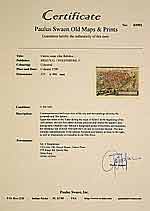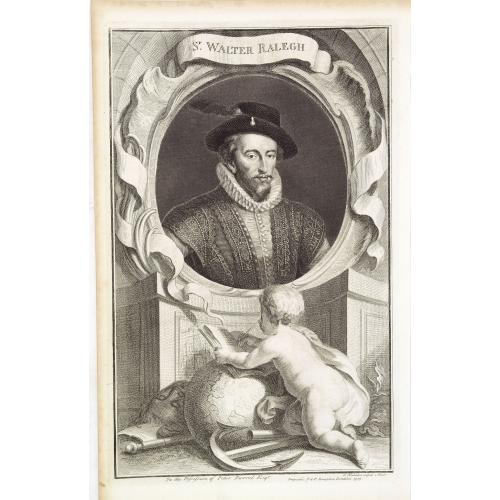Description
Copper engraved portrait of Sir Walter Raleigh (ca. 1554 – 1618) by Jacob Houbraken (1698 – 1780), from Thomas Birch's "The Heads of Ilustrious Persons of Great Britain".
Sir Walter Raleigh was an English aristocrat, writer, poet, soldier, courtier, spy, and explorer. He is also well known for popularising tobacco in England.
Raleigh was born to a Protestant family in Devon, the son of Walter Raleigh and Catherine Champernowne. Little is known for certain of his early life, though he spent some time in Ireland, in Killua Castle, Clonmellon, County Westmeath, taking part in the suppression of rebellions and participating in the Siege of Smerwick. Later he became a landlord of properties confiscated from the Irish rebels.
He rose rapidly in Queen Elizabeth I's favour, and was knighted in 1585. He was involved in the early English colonisation of Virginia under a royal patent. In 1591 he secretly married Elizabeth Throckmorton, one of the Queen's ladies-in-waiting, without the Queen's permission, for which he and his wife were sent to the Tower of London. After his release, they retired to his estate at Sherborne, Dorset.
In 1594 Raleigh heard of a "City of Gold" in South America and sailed to find it, publishing an exaggerated account of his experiences in a book that contributed to the legend of "El Dorado". After Queen Elizabeth died in 1603 Raleigh was again imprisoned in the Tower, this time for allegedly being involved in the Main Plot against King James I, who was not favourably disposed toward him. In 1616 he was released to lead a second expedition in search of El Dorado. This was unsuccessful and men under his command ransacked a Spanish outpost. He returned to England and, to appease the Spanish, was arrested and executed in 1618.
Raleigh's plan in 1584 for colonisation in the "Colony and Dominion of Virginia" (which included the present-day states of North Carolina and Virginia) in North America ended in failure at Roanoke Island, but paved the way for subsequent colonies. His voyages were funded primarily by himself and his friends, and never provided the steady stream of revenue necessary to start and maintain a colony in America. (Subsequent colonisation attempts in the early 17th century were made under the joint-stock Virginia Company, which was able to collect the capital necessary to create successful colonies.)
In 1587, Raleigh attempted a second expedition, again establishing a settlement on Roanoke Island. This time, a more diverse group of settlers was sent, including some entire families, under the governance of John White. After a short while in America, White was recalled to England to find more supplies for the colony. He was unable to return the following year as planned, however, because the Queen had ordered that all vessels remain at port for potential use against the Spanish Armada. The threat of the Armada was only partially responsible for delaying White's return until 1590. After England's victory over the Spanish fleet in 1588, the ships were given permission to sail. Unfortunately for the colonists at Roanoke, the small fleet made an excursion toward Cuba. They tried to capture the treasure-laden Spanish merchant ships reported to be proliferate in those waters at that time. White is said to have objected to this unplanned foray, but was helpless to dissuade the crews.
They had been told of the enormous riches to be had by the experienced Portuguese pilot hired by Raleigh to navigate the voyage. It was not until 1590, 3 years later, that the supply vessel arrived at the colony, only to find that all colonists had disappeared.
List of Explorers and Mapmakers [+]
Sir Walter Raleigh was an English aristocrat, writer, poet, soldier, courtier, spy, and explorer. He is also well known for popularising tobacco in England.
Raleigh was born to a Protestant family in Devon, the son of Walter Raleigh and Catherine Champernowne. Little is known for certain of his early life, though he spent some time in Ireland, in Killua Castle, Clonmellon, County Westmeath, taking part in the suppression of rebellions and participating in the Siege of Smerwick. Later he became a landlord of properties confiscated from the Irish rebels.
He rose rapidly in Queen Elizabeth I's favour, and was knighted in 1585. He was involved in the early English colonisation of Virginia under a royal patent. In 1591 he secretly married Elizabeth Throckmorton, one of the Queen's ladies-in-waiting, without the Queen's permission, for which he and his wife were sent to the Tower of London. After his release, they retired to his estate at Sherborne, Dorset.
In 1594 Raleigh heard of a "City of Gold" in South America and sailed to find it, publishing an exaggerated account of his experiences in a book that contributed to the legend of "El Dorado". After Queen Elizabeth died in 1603 Raleigh was again imprisoned in the Tower, this time for allegedly being involved in the Main Plot against King James I, who was not favourably disposed toward him. In 1616 he was released to lead a second expedition in search of El Dorado. This was unsuccessful and men under his command ransacked a Spanish outpost. He returned to England and, to appease the Spanish, was arrested and executed in 1618.
Raleigh's plan in 1584 for colonisation in the "Colony and Dominion of Virginia" (which included the present-day states of North Carolina and Virginia) in North America ended in failure at Roanoke Island, but paved the way for subsequent colonies. His voyages were funded primarily by himself and his friends, and never provided the steady stream of revenue necessary to start and maintain a colony in America. (Subsequent colonisation attempts in the early 17th century were made under the joint-stock Virginia Company, which was able to collect the capital necessary to create successful colonies.)
In 1587, Raleigh attempted a second expedition, again establishing a settlement on Roanoke Island. This time, a more diverse group of settlers was sent, including some entire families, under the governance of John White. After a short while in America, White was recalled to England to find more supplies for the colony. He was unable to return the following year as planned, however, because the Queen had ordered that all vessels remain at port for potential use against the Spanish Armada. The threat of the Armada was only partially responsible for delaying White's return until 1590. After England's victory over the Spanish fleet in 1588, the ships were given permission to sail. Unfortunately for the colonists at Roanoke, the small fleet made an excursion toward Cuba. They tried to capture the treasure-laden Spanish merchant ships reported to be proliferate in those waters at that time. White is said to have objected to this unplanned foray, but was helpless to dissuade the crews.
They had been told of the enormous riches to be had by the experienced Portuguese pilot hired by Raleigh to navigate the voyage. It was not until 1590, 3 years later, that the supply vessel arrived at the colony, only to find that all colonists had disappeared.
List of Explorers and Mapmakers [+]
FAQ - Guarantee - Shipping
Buying in the BuyNow Gallery
This item is available for immediate purchase when a "Add to Cart" or "Inquire Now" button is shown.
Payments are accepted in Euros or US Dollars. We accept most major credit cards, PayPal and bank transfer.
Authenticity Guarantee
 We provide professional descriptions, condition report and HiBCoR rating (based on 45 years experience in the map business)
We provide professional descriptions, condition report and HiBCoR rating (based on 45 years experience in the map business)
We fully guarantee the authenticity of items we sell. We provide a certificate of authenticity for each purchased item.
Condition / Coloring
We indicate the condition of each item and use our unnique HiBCoR grading system in which four key items determine a map's value: Historical Importance, Beauty, Condition/Coloring and Rarity.
We offer many maps in their original black and white condition. We do not systematically color-up maps to make them more sellable to the general public or buyer.
Copper engraved or wood block maps are always hand colored. Maps were initially colored for aesthetic reasons and to improve readability. Nowadays, it is becoming a challenge to find maps in their original colors and are therefor more valuable.
We use the following color keys in our catalog:
Original colors; mean that the colors have been applied around the time the map was issued.
Colored; If the colors are applied recently or at the end of the 20th century, then "colored", or "attractive colors" will be used.
Original o/l colors; means the map has only the borders colored at the time of publication.
Read more about coloring of maps [+]
FAQ
Please have a look for more information about buying in the BuyNow gallery.
Many answers are likely to find in the general help section.
Virtual Collection
![]()
With Virtual Collection you can collect all your favorite items in one place. It is free, and anyone can create his or her Virtual map collection.
Unless you are logged in, the item is only saved for this session. You have to be registed and logged-in if you want to save this item permanently to your Virtual Collection.
Read More [+]
If you want to save the items permanently, please sign in
or create account first. ![]()
Registering Here, it is and you do not need a credit card.
Add this item to
Virtual Collection
or click the following link to see my Virtual Collection.
Invoice
The invoice and certificates of authenticity are available in the client center >Invoices
| Digital Image Download | |
|
Paulus Swaen maintains an archive of most of our high-resolution rare maps, prints, posters and medieval manuscript scans. We make them freely available for download and study. Read more about free image download |
In accordance with the EU Consumer Rights Directive and habitually reside in the European Union you have the right to cancel the contract for the purchase of a lot, without giving any reason.
The cancellation period will expire 14 calendar days from the day after the date on which you or a third party (other than the carrier and indicated by you) acquires, physical possession of the lot. To exercise the right to cancel you must inform Paulus Swaen Inc, of your decision to cancel this contract by a clear statement (e.g. a letter sent by post, or e-mail (amsterdam@swaen.com).
To meet the cancellation deadline, it is sufficient for you to send your communication concerning your exercise of the right to cancel before the cancellation period has expired.
